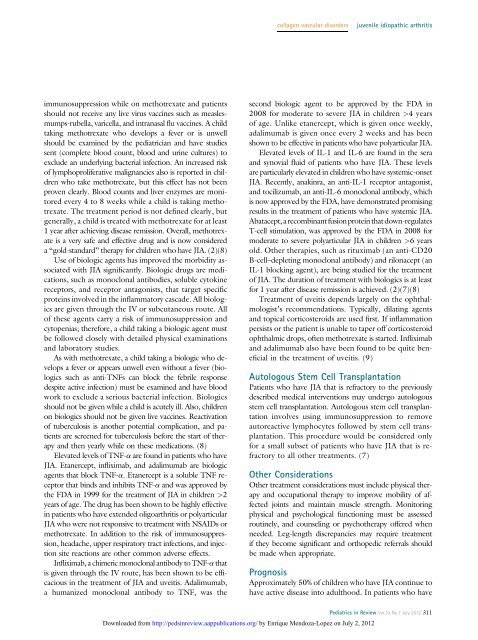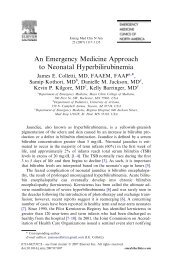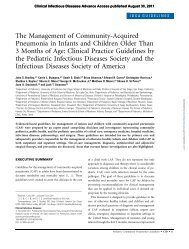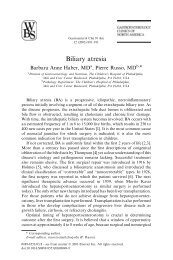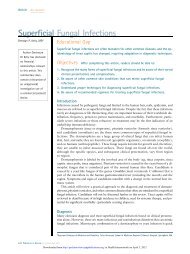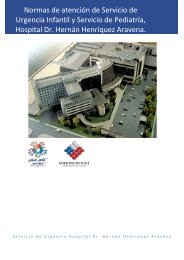An 11-year-old Girl Who Has Left Leg Pain
An 11-year-old Girl Who Has Left Leg Pain
An 11-year-old Girl Who Has Left Leg Pain
Create successful ePaper yourself
Turn your PDF publications into a flip-book with our unique Google optimized e-Paper software.
collagen vascular disordersjuvenile idiopathic arthritisimmunosuppression while on methotrexate and patientsshould not receive any live virus vaccines such as measlesmumps-rubella,varicella, and intranasal flu vaccines. A childtaking methotrexate who develops a fever or is unwellshould be examined by the pediatrician and have studiessent (complete blood count, blood and urine cultures) toexclude an underlying bacterial infection. <strong>An</strong> increased riskof lymphoproliferative malignanciesalsoisreportedinchildrenwho take methotrexate, but this effect has not beenproven clearly. Blood counts and liver enzymes are monitoredevery 4 to 8 weeks while a child is taking methotrexate.The treatment period is not defined clearly, butgenerally, a child is treated with methotrexate for at least1 <strong>year</strong> after achieving disease remission. Overall, methotrexateis a very safe and effective drug and is now considereda “g<strong>old</strong>-standard” therapy for children who have JIA. (2)(8)Use of biologic agents has improved the morbidity associatedwith JIA significantly. Biologic drugs are medications,such as monoclonal antibodies, soluble cytokinereceptors, and receptor antagonists, that target specificproteins involved in the inflammatory cascade. All biologicsare given through the IV or subcutaneous route. Allof these agents carry a risk of immunosuppression andcytopenias; therefore, a child taking a biologic agent mustbe followed closely with detailed physical examinationsand laboratory studies.As with methotrexate, a child taking a biologic who developsa fever or appears unwell even without a fever (biologicssuch as anti-TNFs can block the febrile responsedespite active infection) must be examined and have bloodwork to exclude a serious bacterial infection. Biologicsshould not be given while a child is acutely ill. Also, childrenon biologics should not be given live vaccines. Reactivationof tuberculosis is another potential complication, and patientsare screened for tuberculosis before the start of therapyand then <strong>year</strong>ly while on these medications. (8)Elevated levels of TNF-a are found in patients who haveJIA. Etanercept, infliximab, and adalimumab are biologicagents that block TNF-a. Etanercept is a soluble TNF receptorthat binds and inhibits TNF-a and was approved bythe FDA in 1999 for the treatment of JIA in children >2<strong>year</strong>s of age. The drug has been shown to be highly effectivein patients who have extended oligoarthritis or polyarticularJIA who were not responsive to treatment with NSAIDs ormethotrexate. In addition to the risk of immunosuppression,headache, upper respiratory tract infections, and injectionsite reactions are other common adverse effects.Infliximab, a chimeric monoclonal antibody to TNF-a thatis given through the IV route, has been shown to be efficaciousin the treatment of JIA and uveitis. Adalimumab,a humanized monoclonal antibody to TNF, was thesecond biologic agent to be approved by the FDA in2008 for moderate to severe JIA in children >4 <strong>year</strong>sof age. Unlike etanercept, which is given once weekly,adalimumab is given once every 2 weeks and has beenshown to be effective in patients who have polyarticular JIA.Elevated levels of IL-1 and IL-6 are found in the seraand synovial fluid of patients who have JIA. These levelsare particularly elevated in children who have systemic-onsetJIA. Recently, anakinra, an anti-IL-1 receptor antagonist,and tocilizumab, an anti-IL-6 monoclonal antibody, whichis now approved by the FDA, have demonstrated promisingresults in the treatment of patients who have systemic JIA.Abatacept, a recombinant fusion protein that down-regulatesT-cell stimulation, was approved by the FDA in 2008 formoderate to severe polyarticular JIA in children >6 <strong>year</strong>s<strong>old</strong>. Other therapies, such as rituximab (an anti-CD20B-cell–depleting monoclonal antibody) and rilonacept (anIL-1 blocking agent), are being studied for the treatmentof JIA. The duration of treatment with biologics is at leastfor 1 <strong>year</strong> after disease remission is achieved. (2)(7)(8)Treatment of uveitis depends largely on the ophthalmologist’srecommendations. Typically, dilating agentsand topical corticosteroids are used first. If inflammationpersists or the patient is unable to taper off corticosteroidophthalmic drops, often methotrexate is started. Infliximabandadalimumabalsohavebeenfoundtobequitebeneficialin the treatment of uveitis. (9)Autologous Stem Cell TransplantationPatients who have JIA that is refractory to the previouslydescribed medical interventions may undergo autologousstem cell transplantation. Autologous stem cell transplantationinvolves using immunosuppression to removeautoreactive lymphocytes followed by stem cell transplantation.This procedure would be considered onlyfor a small subset of patients who have JIA that is refractoryto all other treatments. (7)Other ConsiderationsOther treatment considerations must include physical therapyand occupational therapy to improve mobility of affectedjoints and maintain muscle strength. Monitoringphysical and psychological functioning must be assessedroutinely, and counseling or psychotherapy offered whenneeded. <strong>Leg</strong>-length discrepancies may require treatmentif they become significant and orthopedic referrals shouldbe made when appropriate.PrognosisApproximately 50% of children who have JIA continue tohave active disease into adulthood. In patients who haveDownloaded from http://pedsinreview.aappublications.org/ by Enrique Mendoza-Lopez on July 2, 2012Pediatrics in Review Vol.33 No.7 July 2012 3<strong>11</strong>


